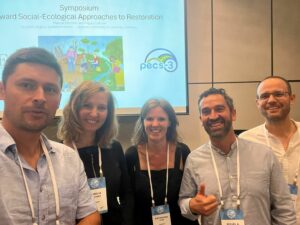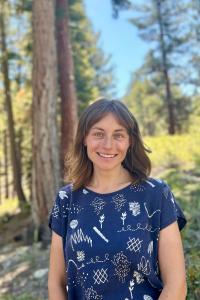Pushing our conceptualization of restoration forward: it’s all about values!
Written by Julia van Velden and edited by Madeline Sides Photos by Manuel Pacheco Romero
“Toward social-ecological approaches to restoration” speakers
The session “Toward social-ecological approaches to restoration”, offered as part of the 2024 PECSIII Conference in Montreal, explored six key ideas on the cutting edge of restoration theory and practice, illustrating them with examples through individual talks. The session focused on exploring how to take the understanding of restoration as a predominately ecological practice, to one which recognizes social (and intertwined social-ecological) components, which can often make or break restoration success.
These six key ideas, outlined by the first speaker, Maraja Riechers, were:
- Adopt the key principles for social-ecological resilience, such as redundancy, connectivity, learning, participation, or polycentric governance, in restoration practice.
- Recognize that people act as stewards who navigate complexity, rather than attempting to control this complexity within social-ecological systems.
- Use relational values to bridge gaps and answer questions of what should be conserved and restored and why.
- Understand the coevolution of both social and ecological systems, which indicates the need to honour biocultural diversity in restoration.
- Recognise the long-range connections of social-ecological systems, which means that telecoupling and spillovers between ecosystems need to be considered in restoration actions.
- Targeting of “deep” leverage points may be necessary, rather than simply engaging with the most “visible” factors. Restoration success may not depend on only ecological factors, but also on factors such as engagements with powerful actors.
The second speaker, Manuel Pacheco-Romero, illustrated the complexity of evaluating restoration projects by looking at what makes restoration successful through post-hoc assessment of ecological, social, and social-ecological indicators in grasslands. This allowed the creation of archetypes of restoration success, with the main difference between the different archetypes showing the complexity of social success and the need for supportive societal structures to achieve this type of success.
The third speaker, Miguel Cebrian-Piqueras, showed the complexity of values associated with restoration, and how the values of individuals and groups may differ. This was illustrated with an example from real-world labs in Germany, where co-design of restoration strategies with local stakeholders is used. These results showed that relational values were less apparent at the collective level than the individual level, with higher consensus and homegenisation of values in group settings. This work indicates how different values may be more or less apparent, depending on the level of interrogation, which may impact which values are acted upon in decision-making contexts. Both individual and group values are therefore important to unravel.
The fourth speaker, Felipe Benra, explored the need for assessing what, where, and how an area should be restored, before the restoration project even starts. This was illustrated with landowners in a working biocultural landscape in southern Chile. Exploring the values landowners may have towards restoration showed that stewardship and care were dominant values, and that forests were particularly important for relational values. This illustrates how values may help to legitimize or de-legitimize restoration projects before they even begin.
The final speaker, Katharina Löhr, described how restoration projects can serve as entry points for achieving social cohesion in the way they promote information exchange and offer spaces for stakeholder interaction. Katharina gave examples from Ethiopia and Togo, where restoration has acted as a point of cooperation for communities. Restoration activities can lead to improved social-ecological outcomes by increasing social cohesion both vertically (between state and society) and horizontally (between societal groups), and in this was act as leverage point for improved social-ecological outcomes.
The session ended with a panel which discussed why, amongst a range of environmental activities, ecological restoration may be particularly special for creating positive social-ecological impacts. By recognizing that restoration activities open spaces for increased relationality and connection with nature, deeper leverage points for societal action might be found. However, the session also emphasized that, although relational values are often present in restoration landscapes, they are not sufficiently recognized in policy and methods, limiting the ability to create change through these values.



